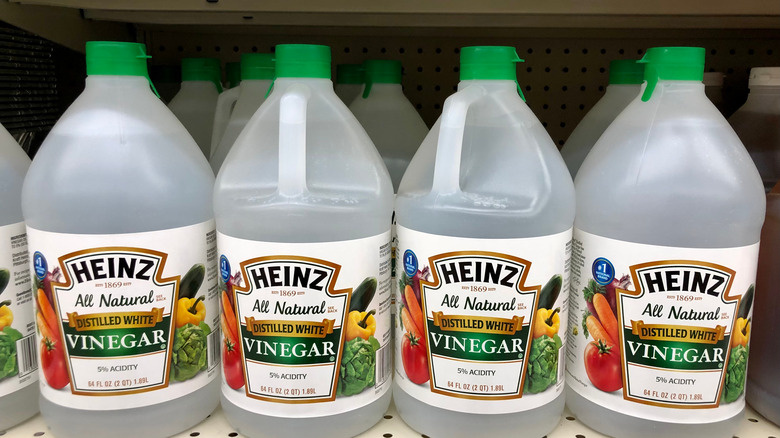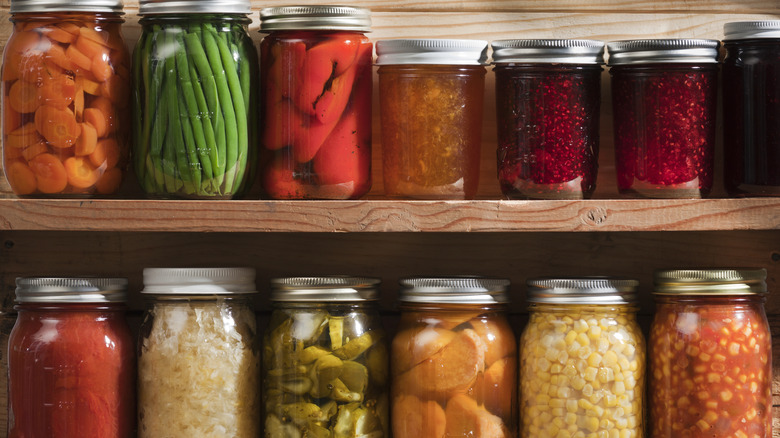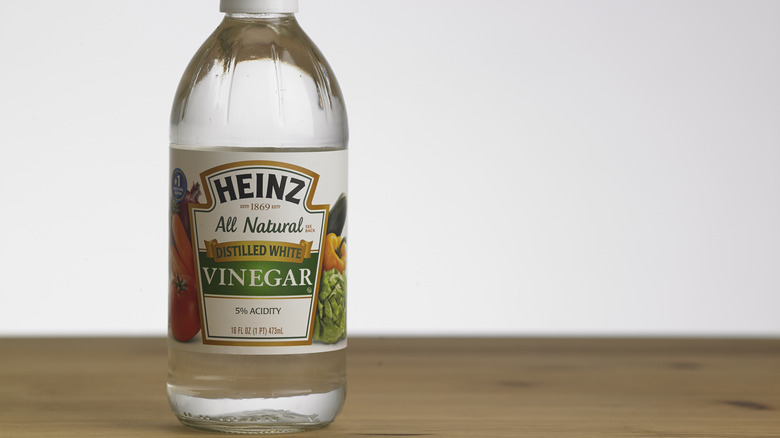The Vinegar Label To Watch Out For When Making Your Own Pickles
When harvest season rolls around and the farmers markets, farm stands, and backyard gardens are bursting with fresh produce, it's impossible to eat everything before it goes bad, no matter how many salads and soups you make. Thankfully, nothing has to go to waste if you learn how to make pickles and do some home canning. With a little know-how, some glass canning jars and lids, and the right ingredients, you can be crunching on homemade pickles in the dead of winter — long after the garden has been put to bed. It's essential, however, that when you do any pickling and canning, you follow certain guidelines to make sure that the food you're preserving is safe to eat later. Pickles, specifically, need to be made with vinegar that has 5% acidity to prevent spoilage. Unfortunately, it's easy to grab a bottle of vinegar at the store without realizing it's not acidic enough.
If you're heading to the market for home pickling supplies, look for bottles of white distilled vinegar labeled explicitly as 5% acid. There are a lot of bottles on the market that are only 4%, and if you don't notice, you could end up throwing a lot of hard work in the trash or getting sick.
Pickling basics and the 5% standard
In the grand scheme of food preservation, pasteurization, freezing, and refrigeration are the new kids on the block. Long before Louis Pasteur discovered a way to kill bacteria to keep food fresh longer, and modern refrigeration was perfected, our ancestors figured out that submerging food in an acidic solution would make it last longer. These days you don't need to pickle food to preserve it, but it's still a great way to stretch the season's fresh vegetables. Also, pickles are delicious. Cucumbers get all the glory in the pickleverse, but lots of veggies can become home-canned pickles, like green beans, beets, mushrooms, radishes, and carrots. Even meat and eggs can be pickled and canned. Regardless of the pickling recipe, however, if the plan is to can the pickles to make them shelf stable (as opposed to quick-made refrigerator pickles), it's imperative that the pickling solution have a high enough acidity to ward off bacteria that can make you sick.
The widely accepted guideline for canning pickles or other acidic foods is to have a pH of 4.6 or lower, according to Clemson University. Anything less acidic will allow Clostridium botulinum to grow, even if the canning jar is boiled at 212 degrees Fahrenheit. Luckily, it's easy to get the proper pH in a jar of pickles by using distilled white vinegar that has 5% acidity. The problem, however, is that lower-acid white vinegar is becoming more common in grocery stores.
Read your labels
Canning and pickling have become super popular, fueled initially by hobbyists and homesteaders during the pandemic and later in response to record-high grocery inflation. These days there are tons of picklers active online, and they've begun to notice an increase in bottles of vinegar on grocery store shelves that aren't acidic enough for safe canning.
Watch on TikTok
Several university extension services have also put out warnings about the low-acid vinegar, including the University of Illinois Urbana-Champaign, which noted in July 2023, "The National Center for Home Food Preservation strongly advises against using vinegar with acidity levels of less than 5%, as it may not be sufficiently strong to ensure the safety of the canned products. The center also urges home canners to remember to check the vinegar label for its acidity level."
If you've already made a batch of pickles with the lower acid vinegar, throw them away if they've been at room temperature for more than 24 hours; if they're less than 24 hours old, you can still refrigerate them. Going forward, if you get really into pickling, get some pH test strips or a pH meter to be sure that everything you make is safe for canning. If you're only going to pickle every now and then, just follow a solid, proven recipe, and make sure to use the right vinegar.


